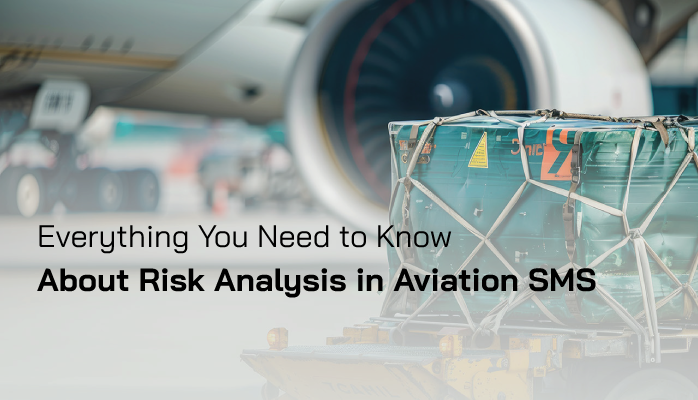The Multiple Faces of What Risk Is

The layperson's perception and understanding of risk is something that tends to make aviation safety professionals slightly indignant. In order to be successful in the aviation safety field, safety managers must intimately understand the core elements affecting operational safety, including:
- Equipment;
- Manpower; and
- Environment.
Modern aviation safety management systems (SMS) are designed to provide aviation service providers with a proven, standardized framework to reduce risk to as low as reasonably practical (ALARP). Yet what is the risk?
Related Aviation Risk Management Articles
- What Is Difference Between Hazard and Risk in Aviation SMS
- How to Identify Hazards and Assess Risks in Aviation SMS - With Free Resources
- Types of Operational Risk for Airline SMS
Why Is Risk So Important in Aviation SMS?
After I became an aviation safety professional, I was tasked with developing an SMS database that tracked and documented operational hazards and risks. Now I consider myself an intelligent person; however, my understanding of hazards and risks was not correct at this time. In fact, my head was on backward!
My lack of formal safety risk management education became immediately apparent to aviation safety SMEs (subject-matter experts) when I started discussing workflows surrounding proactive hazard and risk management. I felt like a schoolchild being chastised for forgetting how to spell a common word, like "piece," with its crazy "i" before the "e" rule. I was naturally embarrassed, and I was surprised at how indignant safety managers acted when my ignorance became apparent.
In short, the risk to a layperson is not the same as to an aviation safety professional. The fact is that safety professionals can be more than a little possessive about their definitions, and how they conceptualize particular safety elements. Yet this is natural. If professionals are to collaborate on a broad, nebulous concept called aviation safety, it becomes incredibly important that they all share the same common vocabulary. When there are competing definitions for "risk" or "hazards," confusion will naturally reign.
What Is Risk According to FAA?
When it comes to aviation risk, the majority of safety managers will note that
Risk is the composite of predicted severity and likelihood of potential effects of a hazard [occurrence]
(14 CFR § 5.5)
Unfortunately, it’s not quite that simple in real-world operations. There are actually two ways we talk about risk:
- Risk in general: combination of severity and likelihood of safety mishap;
- You would say, “The risk” of X, Y, or Z”
- Primary marker is inclusion measurable (quantitative) severity and likelihood
- Used in Risk Assessment
- A specific risk: a safety mishap, accident, etc.
- You would say, “What are the chances of “a risk” occurring?
- The primary marker is that it’s an outcome involving damages of some kind
- Used in Risk Analysis
“What is the risk of a risk?” You can see how and why the idea of risk can become confusing. When you see the word “risk” you need to carefully consider:
- The context of the conversation – is likelihood/severity being discussed, or is a specific mishap being discussed?
Establishing this context will save much confusion and miscommunication in your aviation SMS program.
Risk Analysis Process

So, the question is: does “risk analysis” refer to:
- Risk in general; or
- A specific mishap?
In fact, risk analysis addresses both faces of risk, as it:
- Is used to analyze all facets of a specific risk; and
- In order to understand the risk of that mishap occurring, which is documented with risk assessment.
It’s extremely important to point out again that risk in general is a function of Risk Assessment, and a specific risk is used in risk analysis. Even official documents tend to confuse this fact by using “risk analysis” and “assessing risk” interchangeably. There is a reason risk analysis and risk assessment are two different steps in the Risk Management Process. The whole process works like this:
- Identify a hazard;
- Identify a specific risk associated with the hazard;
- Choose risk analysis model
- Thoroughly review data relevant to the specific risk;
- Understand all elements of the specific risk, such as root causes, mechanisms, etc.; and
- Perform risk assessment of risk likelihood and severity of the specific risk occurring.
As you can see, performing risk analysis involves both conceptions of specific risk and risk in general.
Purpose of Risk Analysis
Performing quality risk analysis in aviation SMS program takes time and practice to master. Real-world situations are often messy, unclear, and organizing these situations into logical parts and in a logical order is, at best, inexact. Then throw in the fact that oversight agencies have specific expectations about how these situations should be managed, and things become even more confusing.
Therefore, risk analysis has two primary purposes:
- Reducing messy, real-life safety issues into clearly organized parts; and
- Ensuring that these “identifiable parts” are the kind that oversight agencies will agree with.
A key point is that risk analysis in aviation SMS is a process with multiple activities and (often) multiple tools that will be used to fulfill the above purposes.
What Are Qualitative and Quantitative Data
Quantitative data is data that is measurable with numbers, such as:
- Quantity;
- Amount; or
- Rate.
Qualitative data is data that is measured by judgment, such as:
- Type (i.e., root cause, human factors);
- Value (i.e., good, bad, etc.); or
- Timeline, such as order of important events.
Qualitative data may be aided by quantitative data, such as by using quantitative data to support a qualitative value judgment. Also, quantitative data may be aided by an expert qualitative judgment in order to assess the value of a piece of quantitative data.
Advantages of Quantitative Data for Risk Analysis

Advantages of using quantitative data are:
- Objective;
- Specific;
- Rational analysis;
- Substantiation of findings;
- Easy to document;
- Hard support of decisions; and
- Used for modeling.
Because of these advantages, quantitative data is looked upon kindlier and with more acceptance than qualitative data. For this reason, it should be the primary tool for risk analysis.
Advantages of Qualitative Data for Risk Analysis
Advantages of qualitative data for risk analysis are:
- Insight into general trends;
- Connect and compare unrelated pieces of quantitative data;
- Assess value of quantitative data; and
- Narrow potential safety decisions.
For example, suppose you are performing risk analysis on a particular accident. Quantitatively, you might data mine for similar historical occurrences. Qualitatively, you might analyze the quality of safety culture in contributing/mitigating the accident, with an outcome like, “Lack of strong safety culture was a root cause for issue as it delayed hazard identification response and allowed the incident to more quickly result in hazard occurrence.”
Final Thought: Tools for Risk Analysis
Here are popular tools for risk analysis in aviation SMS programs:
- Root cause analysis (Qualitative);
- Historical data mining (Quantitative);
- Bowtie analysis (Quantitative);
- Leading indicator analysis (Quantitative);
- Event Trees (Qualitative); and
- SMS Shortfall Analysis (Qualitative).
Here is a great resource for helping you establish how well you understand hazards and risks, which will greatly aid you in your risk analysis, as well as guidance for your risk management process:
Last updated January 2025.







